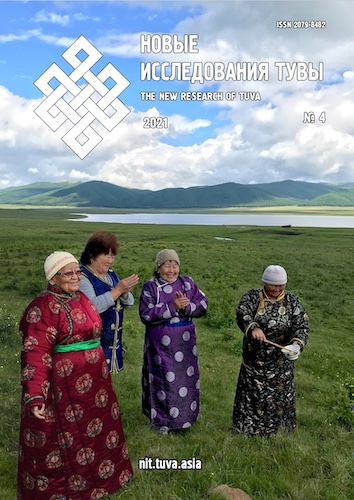A lexicographical description of Tuvan proverbs: Principles, structure and an ethnolinguoculturological commentary as compared to European paremies
DOI:
https://doi.org/10.25178/nit.2021.4.11Keywords:
lexicography; paremiology; proverb; structural semantic model; multilingual dictionary; Tuvan language; Tuvan folklore; modern European languageAbstract
Due to the absence of a typological description of Tuvan proverbs, the Tuvan proverb corpus seems to appear in an artificial isolation. On the contrary, it must be seen for what it is – an organic part of the Eurasian paremiological continuum. This part has both proverbs it shares with other languages and unique ones which mark the ethnocultural distinctiveness of the Tuvan people. It is thus of utter importance (and ultimate difficulty) that a lexicographical description of Tuvan proverbs must be built with paremiology of European language as its background.
The aim of this study is to lay a methodological foundation for a description of Tuvan proverb corpus compared against European proverbs – a foundation which should cover its principles, structure and ethnolinguocultural commentary.
Looking for factual material, we turn to editions of collections of Tuvan proverbs and sayings, to dictionaries, including the most authoritative paremiological dictionaries of modern European languages, such as the ones edited by E. Strauss, G. Paczolay, K. Grigas, V.M. Mokienko, or M. Yu. Kotova.
The description, as well as its principles, is based on the theory of structural semantic modeling, which, in its turn, suggests that each unit of the corpus of Tuvan proverbs should be subjected to a differentianting use of the generality/specificity criterion. Compared against European counterparts, each Tuvan proverb can be seen as fully vs. partly analogous and absolutely vs. correlatively unique (in accordance with the structural semiotic model), the partly analogous further subdivided into ethnolinguistically vs. ethnoculturally assimilated, and the correlatively unique into ethnolinguistically vs. ethnoculturally marked (by key ideas and/or proverbial imagery).
References
Bolat-ool, R. V. and Pelevina, N. N. (2017) Formirovanie obraza zhenshchiny v tuvinskikh i nemetskikh poslovitsakh [On woman's image in Tuvan and German proverbs]. Vestnik Khakasskogo gosudarstvennogo universiteta im. N. F. Katanova, no. 21, pp. 29–32. . (In Russ.)
Bredis, M. A., Lomakina, O. V. and Mokienko, V. M. (2019) Poslovitsa v sovremennoi lingvistike: opredelenie, status, funktsionirovanie [The proverb in modern linguistics: definition, status, and functioning]. Vestnik Moskovskogo universiteta. Seriia 19: Lingvistika i mezhkul'turnaia kommunikatsiia, no. 3, pp. 34–43. . (In Russ.)
Bredis, M. A., Lomakina, O. V. and Mokienko, V. M. (2020) Rusinskaia frazeologiia kak primer kul'turno-iazykovogo transfera v slavianskikh iazykakh (na materiale numerativnykh edinits) [Rusin phraseology as an example of cultural and linguistic transfer in Slavic Languages: The case of numeration units)]. Rusin, no. 60, pp. 198–212. . (In Russ.) DOI: https://www.doi.org/10.17223/18572685/60/12
Bredis, M. A., Dimoglo, M. S. and Lomakina, O. V. (2020) Paremii v sovremennoi lingvistike: podkhody k izucheniiu, tekstoobrazuiushchii i lingvokul'turologicheskii potentsial [Paremias in modern linguistics: Approaching their study, text-building and linguocultural potential.]. RUDN Journal of Language Studies, Semiotics and Semantics, vol. 11, no. 2, pp. 265–284. . (In Russ.) DOI: https://www.doi.org/10.22363/2313-2299-2020-11-2-265-284
Budegechieva, T. B. (2018) Tuvinskaia kul'tura: material'noe i dukhovnoe, traditsii i novatsii [Tuvan culture: the material and the spiritual, traditions and innovations]. Kyzyl, TuvGU Publ. 115 p. . (In Russ.)
Burykin, A. A., Boldyreva, I. M. and Muzraeva, D. N. (2019) Sobaka v kalmytskom i tuvinskom fol'klore [The dog in Kalmyk and Tuvan folklore]. New Research of Tuva, no. 4, pp. 119–132. (In Russ.). DOI: https://www.doi.org/10.25178/nit.2019.4.10
Galiullin, K. R. (2018) Tatar fol'klory tele: mәkal'lәr, kanatly әitelmәlәr, җor süzlәr һәm әitemnәr: süzlek = Iazyk tatarskogo fol'klora: poslovitsy, krylatye vyrazheniia, prislov'ia i pogovorki: slovar' [The language of Tatar folklore: proverbs, proverbial expressions, bywords and sayings: a dictionary]. Kazan, TӘһSI. 588 b. (In Tat.)
Darzha, V. Ch. (2003) Loshad' v traditsionnoi praktike tuvintsev-kochevnikov [The horse in the traditional practice of the Tuvan nomads] / ed. by G. N. Kurbatskii. Kyzyl, TuvIKOPR SO RAN. 184 p. (In Russ.).
Dorzhu, K. B. (2012) Sravneniia v russkikh i tuvinskikh pogovorkakh, poritsaiushchikh otritsatel'nye kachestva cheloveka [Comparisons in Russian and Tuvan sayings that condemn negative qualities of a person]. Vestnik Tuvinskogo gosudarstvennogo universiteta, no. 1, pp. 94–98. . (In Russ.)
Egorova, A. I., Kondakova, A. P. and Kuzhuget, M. A. (2020) Gendernye stereotipy v tuvinskikh poslovitsakh i pogovorkakh [Gender stereotypes in Tuvan proverbs and sayings]. New Research of Tuva, no. 1, pp. 18–31. (In Russ.). DOI: https://www.doi.org/10.25178/nit.2020.1.2
Ivanov, E. E. (2009) Kriterii sistematizatsii aforisticheskogo materiala kak ob"ekta leksikograficheskogo opisaniia [Aphorism as the object of lexicographic description: criteria of systematization]. Journal of Historical, Philological and Cultural Studies, no. 2 (24), pp. 88–91. . (In Russ.)
Ivanov, E. E. (2019a) Aspekty empiricheskogo ponimaniia aforizma [Aspects of empirical understanding of aphorisms]. RUDN Journal of Language Studies, Semiotics and Semantics, vol. 10, no. 2, pp. 381–401. (In Russ.). DOI: https://www.doi.org/10.22363/2313-2299-2019-10-2-381-401
Ivanov, E. E. (2019b) O rekurrentnosti aforisticheskikh edinits v sovremennom russkom iazyke [Aphoristic units and their recurrence in modern Russian language]. Russian Language Studies, vol. 17, no. 2, pp. 157–170. (In Russ.). DOI: https://www.doi.org/10.22363/2618-8163-2019-17-2-157-170
Ivanov, E. E. (2020) Aforizm kak ob’ekt lingvistiki: osnovnye priznaki [Aphorism as an object of linguistics: the main properties]. RUDN Journal of Language Studies, Semiotics and Semantics, vol. 11, no. 4, pp. 659–706. (In Russ.). DOI: https://www.doi.org/10.22363/2313-2299-2020-11-4-659-706
Ivanov, E. E., Lomakina, O. V. and Nelyubova N. Yu. (2021) Semanticheskii analiz tuvinskikh poslovits: modeli, obrazy, poniatia (na evropeiskom paremiologicheskom fone) [Semantic analysis of Tuvan proverbs: models, imagery, concepts (against the European paremiological background)]. New Research of Tuva, no. 3, pp. 232-248. (In Russ.). DOI: https://www.doi.org/10.25178/nit.2021.3.17
Іvanova, S. and Іvanoў, Ia. (1997) Sloўnіk belaruskіkh prykazak, prymavak і krylatykh vyrazaў [A dictionary of Belarusian proverbs, sayings and catch phrases]. Mіnsk, BFS. 262 p. (In Bel.)
Іvanoў, Ya. Ya. and Petrusheўskaia, Yu. A. (2021) Asnoўnyia kampanenty prykazkі iak moўnai adzіnkі: prykazkavaia strukturna-semantychnaia madel' [The main components of a proverb as a linguistic unit: a proverbial structural and semantic model]. Vestsі BDPU, no. 3, pp. 104–110. (In Bel.)
Kechil-ool, S. V. and Saaia, O. M. (2016) Osobennosti frazeologizmov s komponentom «ukho» v tuvinskom iazyke v sopostavlenii s russkim [Specifics of phraseological units with the component “ear” in the Tuvan language in comparison with the Russian]. Filologicheskie nauki. Voprosy teorii i praktiki, no. 9–2(63), pp. 107–109. (In Russ.)
Kechil-ool, S. V. and Saaia, O. M. (2017) Semanticheskie osobennosti frazeologizmov s komponentom «ruka» v tuvinskom i russkom iazykakh [The semantic peculiarities of phraseological units with the component “Hand” in Tuvan and Russian languages]. Filologicheskie nauki. Voprosy teorii i praktiki, no. 6–1(72), pp. 92–95. . (In Russ.)
Koniashkin, A. M. and Chadamba, Sh. S. (2014a) O nekotorykh osobennostiakh vvedeniia paremii v khudozhestvennyi tekst (na materiale russkikh perevodov) [Some aspects of introducing paroemias into a literary text: the case of Russian translations)]. Mir nauki, kul'tury, obrazovaniia, no. 3(46), pp. 200–202. (In Russ.)
Koniashkin, A. M. and Chadamba, Sh. S. (2014b) Problema perevoda tuvinskikh paremii (na materiale russkikh khudozhestvennykh perevodov) [The problem of translating Tuvan paroemias (on the material of Russian literary translations)]. Mir nauki, kul'tury, obrazovaniia, no. 3(46), pp. 202–204. (In Russ.)
Koniashkin, A. M. and Chadamba, Sh. S. (2017) Lingvokul'turologicheskii aspekt tuvinskikh paremii v tekstakh russkikh khudozhestvennykh perevodov [The linguoculturological aspect of Tuvan paroemias in their literary translations into Russian]. Mir nauki, kul'tury, obrazovaniia, no. 6 (67), pp. 616–618. (In Russ.)
Kotova, M. Yu. (2000) Russko-slavianskii slovar' poslovits (s angliiskimi sootvetstviiami) [A Russian-Slavic dictionary of proverbs, with their English correspondences]. St. Peterburg, SPbGU Publ. 360 p. (In Russ.)
Kurbatskii, G. N. (2001) Tuvintsy v svoem fol'klore (istoriko-etnograficheskie aspekty tuvinskogo fol'klora) [Tuvans in their folklore: Historical and ethnographic aspects of Tuvan folklore)]. Kyzyl, Tuva book publishing house. 464 p. (In Russ.).
Lamazhaa, Ch. K. (2015) Rebenok i detstvo v tuvinskoi kul'ture: traditsii i sovremennost' [The child and childhood in Tuvan culture: traditions and modernity]. Chelovek, no. 4, pp. 51–58. (In Russ.).
Lepta bibleiskoi mudrosti: russko-slavianskii slovar' bibleiskikh vyrazhenii i aforizmov s sootvetstviiami v germanskikh, romanskikh, armianskom i gruzinskom iazykakh [A mite of Biblical wisdom: A Russian-Slavic dictionary of Biblical expressions and aphorisms with their correspondences in Germanic, Romance, Armenian and Georgian languages] (2019): in 2 vols. Z. K. Adamya et al. Mogilev, MGU. 288 + 308 p. (In Russ.)
Lomakina, O. V. and Mokienko, V. M. (2016) Poznavatel'nyi potentsial rusinskikh paremii na fone russkogo i ukrainskogo iazykov [Cognitive potential of Rusin proverbs compared with those in the Russian and Ukrainian languages]. Rusin, no. 3(45), pp. 119–128. (In Russ.). DOI: https://www.doi.org/10.17223/18572685/45/9
Lomakina, O. V. and Mokienko, V. M. (2018) Tsennostnye konstanty rusinskoi paremiologii (na fone ukrainskogo i russkogo iazykov) [Value constants of the Rusin paremiology (compared with the Ukrainian and Russian languages)]. Rusin, no. 4(54), pp. 303–317. (In Russ.). DOI: https://www.doi.org/10.17223/18572685/54/18
Mokienko, V. M., Nikitina, T. G. and Nikolaeva, E. K. (2010) Bol'shoi slovar' russkikh poslovits [The grand dictionary of Russian proverbs]. Moscow, OLMA Media Grupp. 1024 p. (In Russ.)
Neliubova, N. Yu. (2019) Sem'ia kak obshchechelovecheskaia tsennost' vo frantsuzskoi i russkoi poslovichnoi kartine mira [The family as a universal value in the French and Russian proverbial picture of the world]. Filologicheskie nauki. Nauchnye doklady vysshei shkoly, no. 6, pp. 50–59. (In Russ.)
Neliubova, N. Yu., Semina, P. S. and Kazlauskene, V. (2020) Gurmanstvo v ierarkhii tsennostei frantsuzov i bel'giitsev (na materiale poslovits i pogovorok) [Gourmandise in the hierarchy of values: A case study of French and Belgian proverbs and sayings] // Russian Journal of Linguistics. T. 24. № 4. S. 969–990. (In Russ.) DOI: https://www.doi.org/10.22363/2687-0088-2020-24-4-969-990
Neliubova, N. Yu., Khil'tbrunner, V. I. and Ershov, V. I. (2019) Otrazhenie ierarkhii tsennostei v poslovichnom fonde russkogo i frantsuzskogo iazykov [The proverb corpora of Russian and French languages as a reflection of value hierarchies]. Russian Journal of Linguistics, vol. 23, no. 1, pp. 223–243. (In Russ.). DOI: https://www.doi.org/10.22363/2312-9182-2019-23-1-223-243
Paremiologiia bez granits [Paremiology without borders] (2020) / ed. by M. A. Bredis and O. V. Lomakina. Moscow, RUDN Publ. 244 p. (In Russ.).
Paremiologiia v diskurse [Paremiology in Discourse] (2015) / ed. by O. V. Lomakina. Moscow, URSS; Lenand. 294 p. (In Russ.).
Petrushevskaia, Yu. A. (2021) Metodologiia opredeleniia natsional'nogo, internatsional'nogo i universal'nogo v frazeologii i paremiologii belorusskogo iazyka [Methodology for determining the national and the international and universal in the phraseology and paremiology of the Belarusian language]. West — East, vol. 5, no. 1, pp. 61–72. (In Russ.).
Petrusheўskaia, Yu. A. (2020) Unіversal'ny і іnternatsyianal'ny kampanenty ў paremіialagіchnym skladze belaruskai movy: belaruska-іnshamoўny sloўnіk [Universal and international components in the paremiological composition of the Belarusian language: Belarusian-foreign language dictionary]. Magіleў, MDU. 312 p. (In Bel.)
Salchak, A. M. (2019) Obraz volka v tuvinskikh i angliiskikh poslovitsakh [The wolf in Tuvan and English proverbs]. Simvol nauki: mezhdunarodnyi nauchnyi zhurnal, no. 6, pp. 25–27. (In Russ.).
Seliverstova, E. I. (2009) Opyt vyiavleniia poslovichnogo binoma i problema variantnosti [The experience of identifying the proverbial binomial and the problem of variation]. Russkii iazyk v nauchnom osveshchenii, no. 1(17), pp. 182–200. (In Russ.).
Tatarskie narodnye poslovitsy i pogovorki [Tatar folk proverbs and sayings] (2020) / comp. by L. Kh. Mukhametzianova and I. I. Iamaltdinov. Kazan', Tatar Book Publishing House. 301 p. (In Russ.)
Tuvinsko-russkii slovar' [A Tuvan-Russian Dictionary] (1968): c. 22000 words / ed. by E. R. Tenishev. Moscow, Sovetskaia entsiklopediia. 465 p. (In Russ. and Tuv.).
Tuvinsko-russkii slovar' [A Tuvan-Russian Dictionary] (2014). 2nd ed. / ed. by E. R. Tenishev and D. A. Mongush. Kyzyl, OAO «Tyvapoligraf». 648 p. (In Russ. and Tuv.).
Chadamba, Sh. S. (2014) O nekotorykh osobennostiakh perevoda predlozhenii-paremii v tekstakh russkikh khudozhestvennykh perevodov s tuvinskogo iazyka [Some aspects of translating proverbial sentences in the texts of the Russian literary translations from the Tuvan language]. Filologicheskie nauki. Voprosy teorii i praktiki, no. 5–1(35), pp. 191–193. (In Russ.)
Chadamba, Sh. S. (2015) Predlozheniia-paremii v tekstakh russkikh khudozhestvennykh perevodov s tuvinskogo iazyka [Proverbial sentences in the texts of Russian literary translations from the Tuvan language]: Diss. … Candidate of Philology. Abakan. 151 p. (In Russ.).
Chugunekova, A. N. (2019) Simvolika chisel v khakasskoi i tuvinskoi paremiologii [Numerical symbolism in Khakass and Tuvan paremiology]. Mezhdunarodnyi zhurnal gumanitarnykh i estestvennykh nauk, no. 10–2(37), pp. 18–21. (In Russ.)
Grigas, K. (1987) Patarlių paralelės. Lietuvių patarlės su latvuių, baltarusių, rusų, lenkų, vokiečių, anglų, lotynų, prancūzų, ispanų, atitikmenimis. Vilnius, Leydykla Vaga. 662 s. (In Lit.)
Ivanov, E. (2002) Paremiological minimum and basic paremiological stock in Belarusian and Russian). Prague, RSS. 136 p.
Ivanov, E. and Feldman, V. (2007) Principles of the contrastive description of aphoristic paremiology in Belarusian and Russian Languages. Acta Germano-Slavica, vol. 1, pp. 85–97.
Ivanov, E. and Petrushevskaia, Yu. (2015) Etymology of English Proverbs. Journal of Siberian Federal University, Humanities & Social Sciences, vol. 8, no. 5, pp. 864–872.
Lomakina, O. V. (2021) Concepts of God and faith in Uzbek and Tajik proverbs in terms of culture and language transfer theory. European Journal of Science and Theology, vol. 17, no. 2, pp. 125–135.
Muñoz, J. S. (2001) 1001 refranes españoles con su correspondencia en ocho lenguas (alemán, árabe, francés, inglés, italiano, polaco, provenzal y ruso). S. A. Eiunsa : Ediciones Internacionales Universitarias. 444 p. (In Spanish)
Paczolay, G. (1997) European Proverbs in 55 Languages, with Equivalents in Arabic, Persian, Sanskrit, Chinese, and Japanese. Veszprém (Hungary), Veszprémi Nyomda. 528 p.
Strauss, E. (1994) Dictionary of European Proverbs : in 3 vols. London, New York, Routledge.
Published
How to Cite
For citation:
Bredis M. A., Ivanov Eu. Eu., Lomakina O. V., Nelyubova N. Yu. and Kuzhuget Sh. Yu. Leksikograficheskoe opisanie tuvinskikh poslovits: printsipy, struktura, etnolingvokul’turologicheskii kommentarii (na evropeiskom paremiologicheskom fone) [A lexicographical description of Tuvan proverbs: Principles, structure and an ethnolinguoculturological commentary as compared to European paremies]. New Research of Tuva, 2021, no. 4, pp. 143-160. (In Russ.). DOI: https://www.doi.org/10.25178/nit.2021.4.11
Issue
Section

This work is licensed under a Creative Commons Attribution-NonCommercial 4.0 International License.

Author(s) license holder(s) grant rights for their work to the journal (grantee of a license) under the simple non-exclusive open license in accordance with Art. 1286.1 «Open license for a research work, work of literature or fine arts», Civil Code of the Russian Federation.
New Research of Tuva publishes articles under the Creative Commons Attribution-NonCommercial license (CC BY-NC).
Since it is an open license, author(s) reserve the right to upload the article to their institutional repository, submit it to another journal (if it allows republications), or republish it on their own website (in full, or in part).
However, several conditions apply here:
a) The republished version must always contain the name(s) and affiliation(s) of the author(s), the original title and the hyperlink to the original version on the New Research of Tuva website;
b) It must be in open access, free of charge, and no category of readers must be in any way whatsoever advantaged over general readership.
c) should the contribution be submitted elsewhere by its author(s) without substantial modification (30% or more of original text unchanged), the body of the article should contain a disclaimer that the original version was published in New Research of Tuva (with a link to the respective page)
The CC-BY-NC is a non-revocable license which applies worldwide and lasts for the duration of the work’s copyright.













